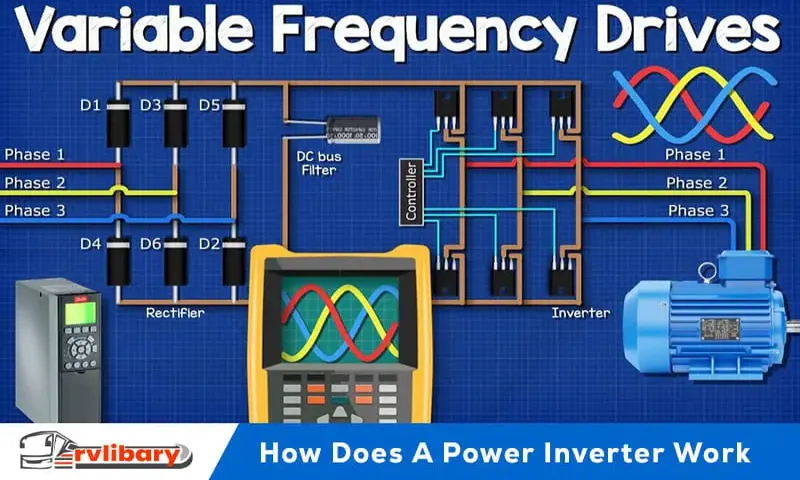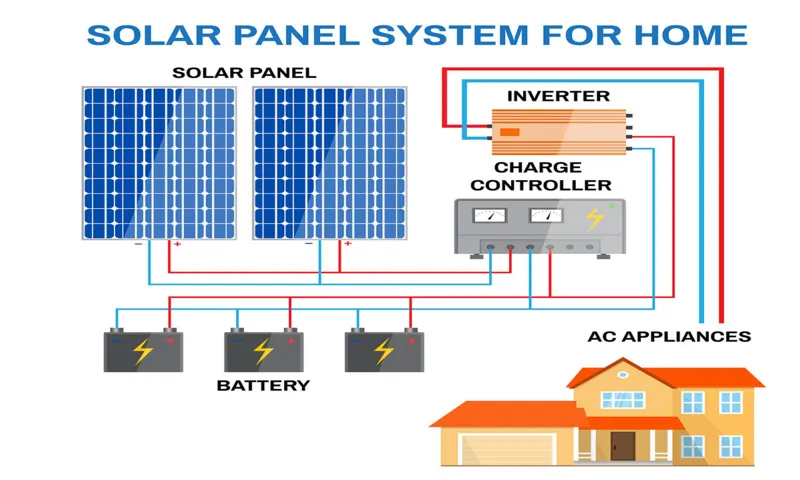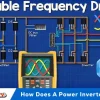So, you’ve probably heard the term “power inverter” thrown around before, but what exactly is it? Well, let’s break it down. Imagine you’re on a road trip and you want to charge your laptop or use your mini fridge in the car. The problem is, your car battery only provides DC (direct current) power, while your electronic devices require AC (alternating current) power.
This is where a power inverter comes in handy. Think of a power inverter as a translator for electricity. It takes the DC power from your car battery and converts it into AC power, allowing you to use your electronic devices on the go.
It’s like having a magic box that transforms your car into a portable power source. But power inverters aren’t just for road trips. They can also be useful in emergency situations, such as during a power outage.
With a power inverter, you can connect it to a car battery or a separate battery bank, providing you with a source of electricity to keep essential devices running. Now, you might be wondering how to choose the right power inverter for your needs. Well, it depends on the wattage of the devices you plan to use.
Different power inverters have different power ratings, so you’ll need to make sure that the inverter can handle the load of your devices. It’s always better to get an inverter with a slightly higher power rating than your devices require to avoid overloading it. So, whether you’re planning a road trip, preparing for an emergency, or simply need a portable power source, a power inverter can be a valuable tool to have.
It gives you the flexibility to use your electronic devices wherever you are, without the need for a traditional AC power source. In the next blog post, we’ll delve deeper into the different types of power inverters and how to choose the right one for your specific needs. Stay tuned!
Table of Contents
Definition and Function of a Power Inverter
Ever wondered how you can use electronic devices like laptops or mobile phones in your car? Well, the key lies in a device called a power inverter. So, what exactly is a power inverter and how does it work in a car? Essentially, a power inverter is a device that converts the direct current (DC) from your car’s battery into alternating current (AC), which is what most electronic devices need to operate. This allows you to use your car’s electrical system to power devices that would normally require an AC power source.
Picture it like a translator, taking the language of your car’s battery and converting it into a language that your electronic devices can understand. Without a power inverter, you would only be able to power devices that were specifically designed to run on DC power. So, the next time you want to charge your phone or run a laptop in your car, remember that it’s all thanks to the handy power inverter working its magic.
What is a power inverter?
power inverter. A power inverter is a device that converts direct current (DC) power from a battery into alternating current (AC) power that can be used to run various electronic devices. It is essentially a portable electrical system that allows you to power up appliances and equipment when you are on the go or in areas where there is no access to electricity.
So, whether you are camping, traveling in an RV, or experiencing a power outage at home, a power inverter can come in handy. It works by taking the DC power from your battery and converting it into the AC power that your devices need to function. This is achieved through a complex process involving electronic circuits and components that change the voltage, frequency, and waveform of the power.
The result is a portable source of electricity that can be used to power anything from laptops and smartphones to kitchen appliances and power tools. With a power inverter, you can have the convenience of electricity wherever you are, giving you the freedom to use your devices and appliances without being tethered to a power outlet.

Why is a power inverter important in a car?
power inverter, car
How does a power inverter work?
power inverter, definition, function, electricity, convert, direct current, alternating current, battery, vehicle, outlet, appliances. A power inverter is a device that is used to convert direct current (DC) electricity into alternating current (AC) electricity. This is an essential function when it comes to powering electronic devices and appliances that require AC power, especially when you are away from a traditional outlet.
So how does a power inverter actually work? Well, it all starts with a battery, whether that be in a vehicle or a standalone battery pack. The DC electricity from the battery is then sent through the power inverter, which uses a series of electronic components to convert it into AC electricity. Once the DC electricity is converted into AC electricity, it can be used to power a wide range of devices and appliances.
This is why power inverters are commonly used in cars, recreational vehicles, and boats, as it allows you to plug in and use your electronic devices just as you would at home. The great thing about power inverters is that they come in different sizes and power capacities, so you can choose the one that best suits your needs. Whether you just need to charge your phone or run larger appliances, there is a power inverter out there that can handle the job.
Overall, power inverters play a crucial role in providing us with the convenience of using our electronic devices and appliances on the go. So next time you’re out camping or on a road trip, remember to pack your power inverter and never go without power again!
Types of Power Inverters for Cars
Power inverters are devices that can convert the DC power from a car’s battery into AC power, allowing you to use electrical devices that require AC power while on the go. There are two main types of power inverters for cars: modified sine wave inverters and pure sine wave inverters. Modified sine wave inverters are the more commonly used type and are suitable for most household electronics like laptops, cell phones, and small appliances.
They produce a stepped waveform that can sometimes cause issues with sensitive electronics. On the other hand, pure sine wave inverters produce a smooth sine wave that’s identical to the AC power produced by utility companies. These inverters are ideal for running more sensitive electronics like medical equipment, power tools, and certain types of appliances.
When choosing a power inverter for your car, it’s important to consider the wattage of the devices you plan to power, as well as the type of wave output that is required. By understanding how different types of power inverters work in cars, you can choose the right one for your needs.
Modified Sine Wave Inverters
power inverters for cars
Pure Sine Wave Inverters
types of power inverters for cars. If you’re looking to power your devices or appliances on the go, a power inverter for your car is a must-have. But with so many different types of power inverters out there, how do you know which one is right for your needs? One popular type of power inverter is the pure sine wave inverter.
Unlike some other inverters, which produce an output that is a modified sine wave, pure sine wave inverters produce a clean and reliable power output that is similar to what you would find in your home. This means that they can safely power even the most sensitive electronics, like laptops, TVs, and medical equipment. So if you’re in need of a power inverter for your car that can handle all of your devices, a pure sine wave inverter is definitely the way to go.
How to choose the right type of power inverter for your car
power inverter for cars, types of power inverters, choose the right type, car accessories, electrical appliances, USB ports, AC outlets, modified sine wave, pure sine wave Are you planning to hit the road for a long drive and want to power your electrical appliances in your car? You might have come across power inverters as a solution, but you may be confused about which type of power inverter is suitable for your car. Well, don’t worry, because I’m here to help you choose the right type! There are two main types of power inverters for cars: modified sine wave and pure sine wave. Modified sine wave inverters are the most common and affordable option.
They convert the DC power from your car’s battery to AC power, which can be used to power a variety of devices such as laptops, smartphones, and small appliances. However, they may not be compatible with certain sensitive devices like medical equipment or digital clocks. On the other hand, pure sine wave inverters produce a smooth and consistent waveform that is almost identical to the AC power you get from your home’s electrical outlets.
These inverters are more expensive but offer a higher level of compatibility with all types of electrical appliances. They are ideal for powering sensitive devices that require a stable power source, including medical equipment, game consoles, and even refrigerators. When choosing the right type of power inverter for your car, consider the specific electrical appliances you want to power.
If you mostly plan to charge smartphones or laptops, a modified sine wave inverter should suffice. However, if you have more sensitive devices or need to power larger appliances, it’s worth investing in a pure sine wave inverter for a better and more stable power output. It’s also important to consider the number of outlets and ports you need.
Some power inverters come with multiple AC outlets and USB ports, allowing you to power multiple devices simultaneously. This can be handy if you’re traveling with a group or have a lot of devices to charge. In conclusion, choosing the right type of power inverter for your car depends on your specific needs and the electrical appliances you plan to power.
Consider the type of waveform, compatibility with sensitive devices, and the number of outlets and ports required. With the right power inverter, you can bring the convenience of your home’s electrical outlets on the road and power your devices wherever you go.
Installation Steps for a Power Inverter in a Car
Power inverters are a great tool to have in your car, as they allow you to convert the DC power from your car’s battery into AC power that you can use to power various electronic devices. So how does a power inverter work in a car? Well, it’s quite simple really. The inverter is connected to your car’s battery and converts the DC power into AC power using a process called inversion.
This inverted AC power is then sent to the outlets on the power inverter, where you can plug in your devices and use them just like you would at home. It’s like having a portable electrical outlet in your car! But before you can start using a power inverter in your car, you’ll need to install it. Luckily, the installation steps are fairly straightforward.
First, you’ll need to find a suitable location in your car to mount the power inverter. This should be a place that is easily accessible and well-ventilated. Once you’ve found the perfect spot, you’ll need to connect the power inverter to your car’s battery using the appropriate cables.
Make sure to follow the manufacturer’s instructions carefully to ensure a proper and safe connection. After that, you’ll just need to connect any devices you want to power to the outlets on the power inverter, and you’re good to go! Just remember to always use caution when using a power inverter in your car, and never exceed the maximum wattage capacity of the inverter.
Step 1: Gather the necessary tools and materials
“power inverter installation in car” Transforming your car into a mobile power station has never been easier with the help of a power inverter. Whether you want to charge your laptop on a road trip or run some power tools while camping, a power inverter is a must-have accessory. But before you get started, make sure you have all the necessary tools and materials on hand.
Firstly, you’ll need a power inverter itself, which can be purchased from any automotive or electronics store. Next, gather some basic tools such as a screwdriver, wire cutters, and electrical tape. You’ll also need some wiring and connectors, which can be found at your local hardware store.
Lastly, make sure you have a good understanding of your car’s electrical system and have a wiring diagram specific to your vehicle. With all these tools and materials in place, you’re ready to move on to the next step in installing your power inverter.
Step 2: Determine the ideal location for the power inverter
power inverter, car, installation, ideal location
Step 3: Mount the power inverter securely
In Step 3 of installing a power inverter in your car, it’s important to secure the inverter in a safe and sturdy manner. This will prevent it from moving or shifting while you’re driving, reducing the risk of damage or injury. To mount the power inverter securely, you will need to find a suitable location in your car.
This could be under the seats, in the trunk, or in the cargo area. Once you’ve found a spot, use screws or brackets to attach the inverter to a solid surface. Make sure to follow the manufacturer’s instructions and use the appropriate hardware for mounting.
Additionally, you may want to consider using adhesive strips or cable ties to further secure the inverter and any loose cables. By taking the time to mount the power inverter securely, you can ensure that it stays in place and functions properly while you’re on the road.
Step 4: Connect the power inverter to the car’s battery
power inverter, car battery, installation steps. Connecting the power inverter to your car’s battery is an essential step in installing a power inverter in your vehicle. With this step, you will be able to harness the power of your car’s battery to provide electricity for your devices while on the go.
To get started, locate the positive and negative terminals on your car’s battery. The positive terminal will be indicated with a + symbol, while the negative terminal will be indicated with a – symbol. Before connecting the power inverter, it’s important to make sure your car’s engine is turned off and the key is removed from the ignition to prevent any accidents.
Take the red cable from the power inverter and connect it to the positive terminal of your car’s battery, making sure it is securely attached. Then, take the black cable from the power inverter and connect it to the negative terminal of your car’s battery. Again, ensure that it is tightly connected.
Now, your power inverter is connected to your car’s battery, and you’re ready to power up your devices on the go. It’s important to note that power inverters draw power from the car’s battery, so it’s essential to keep an eye on your car’s battery level to prevent it from draining too much.
Step 5: Test the power inverter
power inverter, test power inverter, car electrical system
Safety Precautions when Using a Power Inverter in a Car
Power inverters are devices that convert DC power from your car’s battery into AC power that can be used to charge or power electronic devices. They work by taking the 12-volt DC power from your car’s battery and using a circuit to convert it into 120-volt AC power, similar to what you would find in a typical household outlet. This allows you to use and charge devices like laptops, cell phones, and other small appliances while on the go.
When using a power inverter in your car, it is important to take some safety precautions. First and foremost, make sure that the inverter you are using is compatible with your car’s electrical system and battery. Check the power rating of the inverter and ensure that it does not exceed the maximum power output of your car’s battery.
It is also important to properly install the power inverter in your car. Most inverters come with detailed instructions on how to mount and connect them. Follow these instructions carefully to avoid any electrical hazards.
Make sure to connect the inverter directly to the car’s battery using heavy gauge cables to minimize voltage drop and prevent overheating. Additionally, be cautious of the devices you are connecting to the inverter. Make sure they are compatible with the power rating of the inverter and do not exceed its maximum capacity.
Overloading the inverter can cause it to overheat or fail, so it’s important to be mindful of the power requirements of your devices. Lastly, always use common sense when using a power inverter in your car. Avoid using the inverter when the car is not running, as it can drain the battery.
Also, be mindful of where you place the inverter, making sure it is in a well-ventilated area to prevent overheating. And never leave the inverter unattended while it is in use. By following these safety precautions, you can safely and effectively use a power inverter in your car to power and charge your devices while on the go.
Potential risks and hazards
safety precautions in power inverter usage in a car”
Tips for safe usage of a power inverter
power inverter, safe usage, car safety precautions
Conclusion
In conclusion, a power inverter is like a wizard in your car, casting its magical spells to convert the DC power from your car’s battery into AC power that can run all your electronic devices. It’s like having a power outlet on the go, enabling you to charge your laptop, run a hairdryer, or even power a mini-fridge while you’re cruising down the highway. So while your car may not have a magic wand, with a power inverter installed, it can definitely perform some magical feats in transforming electrical energy.
Now, excuse me while I go on a road trip and unleash the power of my inverter!
Summary of key points
safety precautions, power inverter, car, use, In this blog section, we will discuss some important safety precautions to keep in mind when using a power inverter in a car. A power inverter can be a convenient tool for providing electricity while on the go, but it is important to use it correctly and safely. Firstly, it is crucial to choose a power inverter with the right wattage for your needs.
Using an inverter with a higher wattage than what you need can be dangerous and can overload your car’s electrical system. Secondly, always make sure to connect the power inverter directly to your car’s battery terminals and not to the lighter socket. This can help prevent any potential electrical fires or damage to your car.
Additionally, it is important to use the proper gauge of wiring and ensure that all connections are secure and insulated to avoid any short circuits or electric shocks. Lastly, it is important to only use the power inverter when the car’s engine is running, as it can drain the car’s battery quickly if used while the engine is off. By following these safety precautions, you can ensure a safe and efficient use of a power inverter in your car.
Final thoughts on power inverters in cars
When using a power inverter in your car, it’s important to prioritize safety. Here are some precautions to keep in mind: Firstly, always read and follow the manufacturer’s instructions. Different power inverters may have different specifications and usage guidelines, so it’s important to familiarize yourself with the specific instructions for the model you are using.
Secondly, make sure to properly secure the power inverter in your car. This can prevent it from shifting or falling during sudden movements or stops, potentially causing damage or injury. Additionally, it’s important to only use the power inverter when the engine is running.
Using it when the car is turned off can drain the battery, leaving you stranded. Furthermore, avoid overloading the power inverter. Each power inverter has a maximum wattage it can handle, so be sure to check the specifications and ensure that the devices you are plugging in do not exceed this limit.
Overloading the inverter can cause it to overheat or even fail, posing a safety risk. Lastly, it’s important to periodically check the power inverter for any signs of damage or wear. If you notice any frayed wires, exposed parts, or other issues, refrain from using it and have it repaired or replaced as soon as possible.
By following these safety precautions, you can ensure that your experience with a power inverter in your car is both efficient and safe. So, stay mindful of these tips and enjoy the convenience and versatility that a power inverter can bring to your travels.
FAQs
How does a power inverter work in a car?
A power inverter in a car converts the DC power from the car’s battery into AC power, allowing you to run and charge electrical devices while on the go.
Can a power inverter drain a car battery?
Yes, if a power inverter is left connected to a car battery without the car running, it can drain the battery over time. It is recommended to disconnect the inverter when not in use.
What size power inverter do I need for my car?
The size of the power inverter you need for your car depends on the wattage of the devices you plan to use. It is recommended to choose an inverter with a higher wattage capacity to ensure it can handle your devices’ power requirements.
Can a power inverter damage my car’s electrical system?
If installed and used properly, a power inverter should not damage your car’s electrical system. However, it is important to follow the manufacturer’s instructions and avoid overloading the inverter’s capacity.
Can I use a power inverter while driving?
Yes, you can use a power inverter while driving to power or charge devices such as laptops, mobile phones, or portable DVD players. Just make sure the inverter is securely mounted and the cables are properly connected.
Is it safe to use a power inverter in a car?
When used following the manufacturer’s instructions, a power inverter is generally safe to use in a car. However, it is essential to avoid operating the inverter in wet or excessively hot conditions as it can pose a safety risk.
Can a power inverter interfere with the car’s electronics?
Properly designed and shielded power inverters should not cause interference with a car’s electronics. However, it is advisable to choose an inverter from a reputable brand and avoid cheap or poorly constructed models that may have minimal filtering capabilities.



